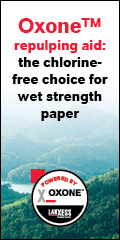
| Archive/Subscribe | TAPPI.org | Advertise | TAPPI Press Catalog | May 2022 |
Resolute Forest Products 1Q 2022 Results: Sales Up By $72 Million Year on Year
Resolute Forest Products Inc. today reported net income for the quarter ended March 31 of $210 million, or $2.68 per diluted share, compared to net income of $87 million, or $1.06 per diluted share, in the same period in 2021. Sales were $945 million in the quarter, an increase of $72 million from the year-ago period. Excluding special items, the company reported net income of $177 million, or $2.26 per diluted share, compared to net income of $119 million, or $1.45 per diluted share, in the first quarter of 2021"We further strengthened the balance sheet with significant cash generation and improved the competitiveness of our business with two tuck-in acquisitions," said Remi G. Lalonde, president and chief executive officer. "Our earnings and cash position reflect favorable pricing momentum in all of our segments, but the transportation network improvements were slower than expected, which led to lower sales volume and higher inventory levels. With our strong balance sheet and liquidity well over $1 billion, we benefit from enhanced flexibility to generate long-term value for shareholders and to drive sustainable economic activity in the communities where we operate." Lalonde added: "I am also pleased to confirm we surpassed our 30 percent absolute greenhouse gas emissions (scope 1 and 2) reduction target, cutting them by 34 percent compared to 2015 levels." Non-GAAP financial measures, such as adjustments for special items and adjusted EBITDA, are explained and reconciled below. Quarterly Operating Income Variance Against Prior Period Consolidated The company reported operating income of $235 million in the quarter, compared to an operating loss of $101 million in the fourth quarter. The improvement reflects higher selling prices in all segments ($206 million) and the net favorable impact of the indefinite idling of pulp and paper operations at the Calhoun (Tennessee) mill ($7 million). This was partially offset by lower shipments as a result of logistics constraints ($29 million), as well as higher fiber ($25 million) and freight expenses ($8 million). The company recorded lower selling, general and administrative expenses ($7 million), mainly due to lower share-based compensation expenses in the quarter. The prior quarter results were unfavorably affected by charges related to the indefinite idling of pulp and paper operations at the Calhoun mill ($171 million). Segment Operating Income Variance Wood Products The wood products segment generated operating income of $219 million in the quarter, a $137 million improvement from the previous quarter. The average transaction price rose to $1,022 per thousand board feet, an increase of $410 per thousand board feet, or 67 percent, from the previous quarter. Production increased by nearly 50 million board feet in the quarter, including improved productivity and the new I-joist capacity, but shipments were 86 million board feet lower as a result of limited rail car and truck availability. This pushed finished goods inventory up by 97 million board feet, to 223 million board feet. The operating cost per unit (or, the "delivered cost") rose by $77 per thousand board feet, or 17 percent, mainly reflecting higher log costs due to stumpage fees and harvesting expenses. EBITDA in the segment improved by $138 million, to $230 million. Market Pulp The market pulp segment recorded operating income of $22 million in the first quarter, $3 million higher than in the prior quarter. The average transaction price increased by $9 per metric ton, or 1 percent, and the delivered cost fell by $8 per metric ton. Shipments were 28,000 metric tons lower, due to the capacity curtailment at the Calhoun mill and logistics constraints, which resulted in an increase in finished goods inventory of 23,000 metric tons. EBITDA in the segment improved by $1 million, to $26 million. Tissue The tissue segment incurred an operating loss of $9 million in the quarter, compared to an operating loss of $6 million in the fourth quarter. The average transaction price increased by $47 per short ton, or 2 percent, due to better product mix, and shipments rose by 1,000 short tons. The delivered cost increased by $141 per short ton, or 7 percent, mostly due to higher pulp prices, including the loss of pulp integration with the pulp capacity curtailment at the Calhoun mill. Finished goods inventory was unchanged at 6,000 short tons. EBITDA in the segment fell by $3 million, to negative $4 million. Paper The paper segment recorded operating income of $25 million in the quarter, an improvement of $29 million over the previous quarter. The average transaction price rose by $37 per metric ton, or 5 percent, due to favorable market conditions in all grades. Shipments slipped by 22,000 metric tons with the capacity curtailment at the Calhoun mill. The delivered cost decreased by $47 per metric ton, or 6 percent, due to lower overall operating costs following the curtailment in Calhoun, partly offset by higher freight costs. Finished goods inventory remained elevated at 85,000 metric tons, as a result of limited rail car and truck availability. Quarter-over-quarter segment EBITDA improved by $22 million, to $34 million. Consolidated Quarterly Operating Income Variance Against Year-Ago Period The operating income in the first quarter was $58 million higher than in the first quarter of 2021. The improvement reflects higher selling prices in all segments ($163 million) and the net favorable impact of the indefinite idling of pulp and paper operations at the Calhoun mill ($13 million), partly offset by lower shipments as a result of logistics constraints ($33 million). The variance also reflects an increase in manufacturing costs ($85 million) due to higher fiber costs ($45 million), mainly due to stumpage and harvesting expenses, as well as higher power, chemical and maintenance expenses ($34 million). Freight costs increased by $16 million due to continued logistics constraints, higher shipping rates and fuel costs. Selling, general and administrative expenses decreased by $9 million on lower share-based compensation expenses. Corporate, Cash and Liquidity The company generated $147 million of cash from operating activities in the quarter and built $67 million of inventory, mainly as a result of logistics constraints and the seasonal build-up of logs ahead of the spring break-up. It invested $13 million, net, in fixed assets. In the quarter, the company expanded its presence in the growing and attractive wood products segment by acquiring the 50 percent equity interests it did not already own in Resolute-LP Engineered Wood Larouche Inc. and Resolute-LP Engineered Wood St-Prime Limited Partnership located in Quebec. Consideration for the transaction was $50 million in cash, net of cash acquired and working capital adjustments. The company's liquidity at quarter-end was $1.1 billion, and the leverage ratio fell to 0.1x on a net debt to last-twelve-months adjusted EBITDA basis. On April 6, Moody's announced a credit rating upgrade to Ba3 from B1 with a stable outlook, as a result of the company's improved financial performance and leverage. By quarter-end, the company recorded cumulative softwood lumber duty deposits of $440 million on the balance sheet, including $43 million paid in the quarter. Outlook "The underlying fundamentals for building materials remain positive, but we are mindful of inflationary pressure and rising interest rates, which could affect pricing and margins. With our network of high-quality pulp and paper assets and structural advantages, such as fiber integration and embedded power generation, we are well-positioned to grow margins in a rising price environment. We continue to work hard to adapt to challenges in the transportation network, and we expect to gradually normalize inventory levels in the second half of the year," added Mr. Lalonde. |



